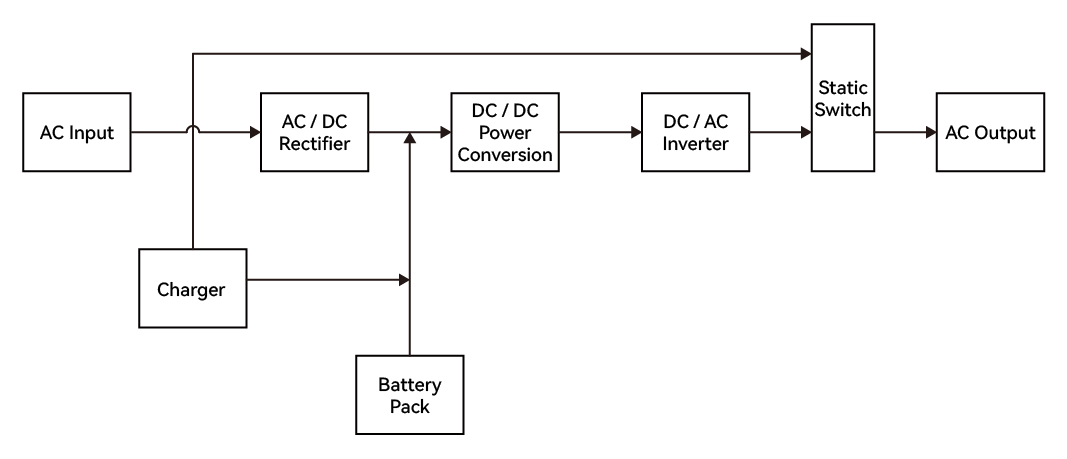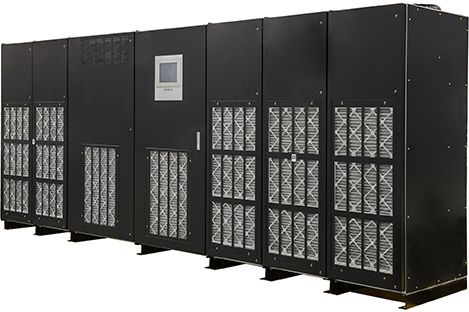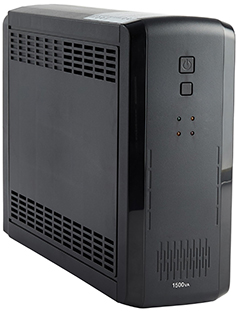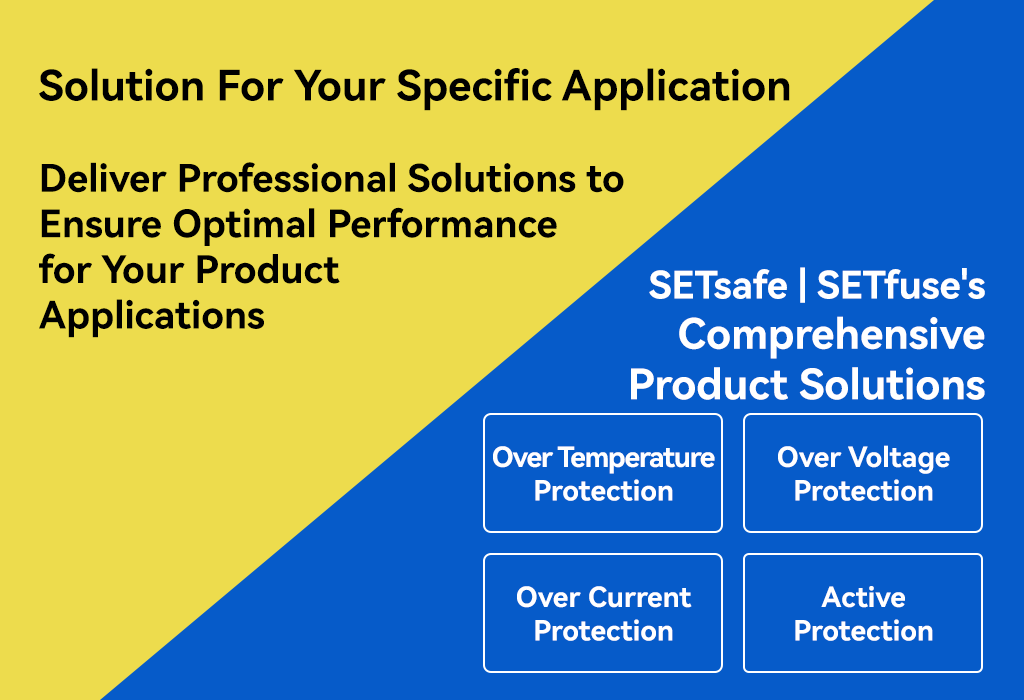Uninterruptible Power Supply (UPS) Circuit Safety Protection SETsafe | SETfuse Solutions & Products
Overview
An Uninterruptible Power Supply (UPS) is a power protection device designed to provide a stable power supply to electronic equipment. It prevents data loss or equipment damage caused by power outages, voltage fluctuations, or power disturbances. A UPS uses a built-in battery to instantly switch to backup power when the main power is interrupted, typically providing power for a few minutes to several hours. It also features voltage regulation and surge protection, making it widely used in data centers, hospitals, industrial facilities, and home electronics to ensure the continuous operation of critical equipment and data security.



Why UPS Needs Circuit Safety Protection
An Uninterruptible Power Supply (UPS) requires circuit safety protection because as a critical power assurance device, it must ensure the safe operation of itself and its connected loads in complex power environments (e.g., grid fluctuations, lightning strikes, load abnormalities). This protection prevents equipment damage, data loss, fire risks, or personal safety accidents. By addressing abnormal voltage, current, temperature, and external interference, circuit safety protection guarantees the UPS's reliability, extends the life of equipment and batteries, and ensures the stable operation of connected devices like servers and medical equipment. The following details the necessity, specific protection items, and relevant certification standards.
Coping with Grid Instability:
The power grid can experience overvoltage, undervoltage, surges, or frequency anomalies. The UPS must use protection mechanisms (e.g., overvoltage protection, surge protection) to stabilize its output, preventing damage to its internal circuits or the connected load.
Preventing Faults from Load Abnormalities:
Load short circuits, overloads, or faults can cause excessive current or overheating. The UPS must have overcurrent, short-circuit, and overload protection to prevent burnout or fire risks.
Protecting Battery Lifespan:
If the UPS's internal battery undergoes deep discharge or overheating, its lifespan will be significantly shortened or it may fail. Battery over-discharge and over-temperature protection can extend battery life.
Ensuring Safety and Reliability:
UPS systems are often used in critical scenarios like data centers and hospitals. Circuit protection (e.g., over-temperature protection, EMI shielding) prevents faults that could lead to data loss or equipment downtime, ensuring continuous operation.
Mitigating Environmental Factors:
High temperatures, lightning strikes, or electromagnetic interference can affect UPS performance. Protection mechanisms (such as over-temperature and surge protection) are crucial for mitigating these external factors.
Complying with Regulations and Industry Requirements:
As a piece of electrical equipment, a UPS must comply with safety standards. Circuit protection is key to ensuring compliance and avoiding legal and safety risks.
Certification Standards (For reference only, please refer to the latest standards and country-specific requirements)
Here are some common mandatory certification standards and their relation to circuit safety protection:
International Electrotechnical Commission (IEC) Standards
IEC 62040 series (e.g., IEC 62040-1):
The main international standard for UPS, specifying safety requirements including the design and testing of protection mechanisms for overvoltage, overcurrent, short circuits, and over-temperature.
European Union CE Certification
CE certification involves the Low Voltage Directive (LVD, 2014/35/EU) and the Electromagnetic Compatibility Directive (EMC, 2014/30/EU), requiring the UPS to have overvoltage, overcurrent, surge protection, and EMI shielding.
U.S. UL Certification
UL 1778:
The North American safety standard for UPS, requiring equipment to have overvoltage, overcurrent, short-circuit, and over-temperature protection functions, and to pass fire and electric shock tests.
China CCC Certification (China Compulsory Certification)
GB/T 7260 (based on IEC 62040):
The Chinese UPS safety standard, requiring equipment to have comprehensive circuit protection functions such as overvoltage, overcurrent, and short-circuit protection.
Other Regional Standards
Australia RCM Certification:
Requires compliance with electrical safety and EMC standards, involving surge protection, overcurrent protection, etc.
Japan PSE Certification:
Requires the UPS to have electrical safety protection to prevent risks caused by overvoltage, short circuits, etc.
Industry-Specific Standards
Medical Industry:
IEC 60601-1 (medical electrical equipment standard) requires a higher level of safety protection for UPS, such as stricter over-temperature and surge protection, to ensure the safe operation of medical equipment.
Data Centers:
The TIA-942 standard indirectly requires the UPS to have comprehensive circuit protection to ensure high reliability.
Common Circuit Safety Protection Items and Reasons
Overvoltage Protection:
Prevents high-voltage from the grid or surges from damaging UPS circuits or the load. This is achieved by using MOVs or voltage detection circuits to limit voltage.
Overcurrent Protection:
Prevents high currents caused by a load short circuit or overload from burning out circuits. Fuses or circuit breakers are used to interrupt the abnormal current.
Over-temperature Protection:
Prevents overheating caused by prolonged operation or poor heat dissipation, protecting the battery and electronic components. This is done via temperature sensors and a control system that reduces power or shuts down the unit.
Short-circuit Protection:
Quickly interrupts a short-circuit current to prevent circuit burnout or fire. Fast-acting fuses or electronic protection circuits are used.
Overload Protection:
Limits output power or shuts down the UPS when the load power exceeds the limit, preventing the UPS from overheating or failing.
Battery Over-discharge Protection:
Prevents the battery from deep discharge, which extends its lifespan. This is managed by the Battery Management System (BMS).
Surge Protection:
Absorbs instantaneous high voltage from lightning strikes or the grid, protecting the UPS and the load. Surge Protective Devices (SPDs) are commonly used.
Active Protection:
Uses intelligent monitoring (of voltage, current, temperature, etc.) to predict faults and proactively adjust operating status or issue warnings, preventing accidents from happening.
UPS systems require circuit safety protection to handle risks from grid fluctuations, load abnormalities, and environmental factors, ensuring equipment reliability, load safety, and user protection. Common protection items include overvoltage, overcurrent, over-temperature, short-circuit, overload, battery over-discharge, surge, and active protection. These mechanisms work together to guarantee the stable operation of the UPS. Certification standards (e.g., IEC 62040, CE, UL, CCC) set clear requirements for UPS circuit protection, ensuring devices operate safely under abnormal conditions and comply with electrical safety and EMC standards. These certifications are not only mandatory for market entry but also crucial for safeguarding user safety and equipment reliability.
SETsafe | SETfuse Solutions, Protection Types, Products, Series
For detailed product specifications, please click "Learn more" to view the product detail page.
Protection Type: Mains Input Overvoltage Protection
Product:
Surge Protective Device (SPD)
Series:
SD20R Learn more
Protection Type: AC/DC Rectifier Module Overvoltage Protection
Product:
Metal Oxide Varistor (MOV)
Series:
10D Learn more
14D Learn more
20D Learn more
Protection Type: AC/DC Rectifier Module Overcurrent Protection
Product:
Cartrige Fuse-links(CFL)
Series:
SCF1032 Learn more
SCF6125 Learn more
SCF61011 Learn more
Protection Type: DC/DC Voltage Conversion Module Overvoltage Protection
Product:
Transient Voltage Suppression Diodes (TVS)
Series:
SMAJ Learn more
SMBJ Learn more
SMCJ Learn more
SMDJ Learn more
Protection Type: ESD Protection for Communication Interfaces
Product:
Transient Voltage Suppression Diodes (TVS)
Series:
SMF Learn more
SMAJ Learn more
Product:
ESD TVS Diode Arrays (ESD TVS)
Series:
GSM24CCAN Learn more
Protection Type: Battery Pack Overcharge Active Protection
Product:
idea Thermal Cutoff (iTCO)
Series:
TPH-R Learn more
JS×××-R Learn more
TKSxxx-R Learn more
TKTxxx-R Learn more
THUxxx-R Learn more
Protection Type: Battery Pack Overcharge Active Protection
Product:
Pyro CutOff (PCO)
Series:
PHW Learn more
Protection Type: AC Output Overcurrent Protection
Product: Cartrige Fuse-links(CFL)
Series:
SCF1032 Learn more
SCF6125 Learn more
SCF61011 Learn more
Partner with SETsafe | SETfuse to Transform Technical Challenges into Reliable Solutions
When you encounter technical challenges in selecting circuit protection components or designing system solutions, the professional engineering team at SETsafe | SETfuse is your trusted partner. Specializing in over-temperature, over-current, over-voltage, and active protection technologies, SETsafe | SETfuse offers comprehensive technical expertise and rapid response to meet your needs. Whether you require precise product parameter guidance or comprehensive system-level protection solutions, SETsafe | SETfuse delivers professional, practical, and efficient recommendations and support.
From initial design consultation and solution implementation to post-sales product assurance, we provide end-to-end collaboration, ensuring your project progresses seamlessly and reliably. For any inquiries or requirements, please contact us at: sales@SETfuse.com
Professional Circuit Protection, Supporting You from Concept to Production


































 Rechargeable Battery
Rechargeable Battery Lithium Battery Thermal Runaway
Lithium Battery Thermal Runaway Electric Power Tool
Electric Power Tool New Energy
New Energy PV Power Generation
PV Power Generation Wind Power Generation
Wind Power Generation Energy Storage Batteries
Energy Storage Batteries Energy Storage System (ESS)
Energy Storage System (ESS) Electric Vehicles
Electric Vehicles EV Charging Stations
EV Charging Stations Light Electric Vehicles
Light Electric Vehicles Home Appliances
Home Appliances Small Household Appliances
Small Household Appliances Large Home Appliance
Large Home Appliance Home Appliance Component
Home Appliance Component Kitchen Appliances (Hotplates ...)
Kitchen Appliances (Hotplates ...) Air Fryer
Air Fryer Coffee Machine
Coffee Machine Electric Iron
Electric Iron Smart Toilet
Smart Toilet Personal Digital Products
Personal Digital Products Lifestyle Appliances
Lifestyle Appliances Office Equipment
Office Equipment Walkie Talkie
Walkie Talkie Medical Analysis Instrument
Medical Analysis Instrument Medical Auxiliary Facility
Medical Auxiliary Facility Medical Instrument
Medical Instrument Lighting
Lighting Indoor Lighting
Indoor Lighting Outdoor Streetlight
Outdoor Streetlight Power Supply
Power Supply Power Supply (Power < 20 Watts)
Power Supply (Power < 20 Watts) HVDC in Data Centers
HVDC in Data Centers Power Supply Unit (PSU)
Power Supply Unit (PSU) Battery Backup Unit (BBU)
Battery Backup Unit (BBU) Uninterruptible Power Supply (UPS)
Uninterruptible Power Supply (UPS) Telecommunication
Telecommunication Automotive
Automotive Power Strip
Power Strip Surge Protection Power Strip
Surge Protection Power Strip Security & Protection
Security & Protection Tethered Drone
Tethered Drone Industrial Robot
Industrial Robot Humanoid Robot
Humanoid Robot Service Robot
Service Robot Specialty Robot
Specialty Robot Agricultural Irrigation Equipment
Agricultural Irrigation Equipment Smart Agricultural Greenhouse
Smart Agricultural Greenhouse Rail Transit Facility
Rail Transit Facility Rail-Vehicle
Rail-Vehicle Railway Power Supply
Railway Power Supply Fuel Dispenser
Fuel Dispenser Traffic Control System
Traffic Control System Traffic Signal Light
Traffic Signal Light Commercial Cleaning Equipment
Commercial Cleaning Equipment Delivery Locker (Drone)
Delivery Locker (Drone) Vending Machine
Vending Machine Lightning Protection Components
Lightning Protection Components HVAC Rooftop Systems
HVAC Rooftop Systems Outdoor Electric Wall Mounted Heater
Outdoor Electric Wall Mounted Heater Flag Explain
Flag Explain






































